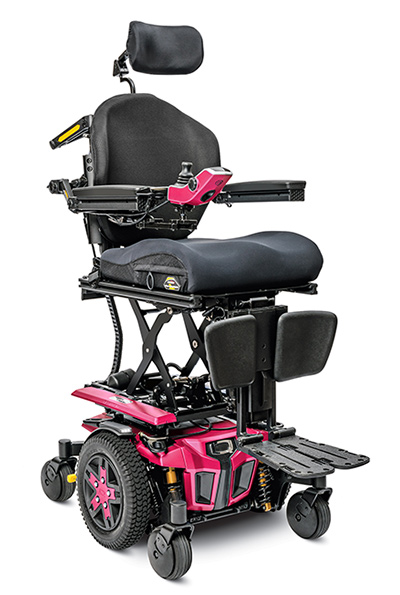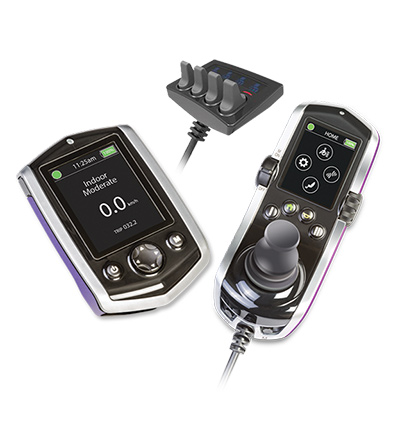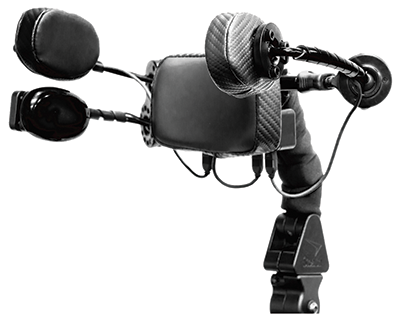Meeting the needs of people living with ALS
Condition
Amyotrophic Lateral Sclerosis (ALS) is a progressive neuromuscular disease which causes neurodegeneration of the motor neurons in the brain and spinal cord. When the motor neurons die, the ability of the brain to initiate and control muscle movements of the body is lost. Due to the documented sudden and rapid decline in function, a person with ALS can go from using a walker to needing a power mobility device very quickly.

Mobility and Assistive Technology Needs
Often, people with ALS require the assistance of power mobility very quickly due to the sudden and rapid progressive nature of the disease.
In the early stages of ALS, a client may require a power chair with a high-back support to assist with positioning and performance of Mobility Related Activities of Daily Living (MRADLs).
If the individual has fairly adequate hand movement for controlling the power chair, then a joystick should be used since it provides the most direct control for driving a power base. It is often advised to provide a client with a hand controller that has switch jacks. As the user’s ability changes, switches can be added to operate on/off and mode operations.
As the disease continues to progress, the individual may find he or she has a limited amount of time during the day when a joystick can be operated. It is at this time that more advanced electronics, such as a mini-proportional joystick, head-array or chin control may need to be considered to operate the power chair.
The individual will likely require the use of postural support components and power positioning functions to assist in pressure relief, postural realignment and function.
These components may also help with transfers, sitting tolerance and comfort. The power positioning options for consideration include power tilt and recline systems, power adjustable seat height, power articulating leg rests or a power articulating foot platform. Providing a power base that can accept oxygen, and eventually a ventilator, is also very consequential. Optional LED fender lights on the Q6 Edge® 2.0 and Q6 Edge® HD (standard on iLevel® the Q6 Edge® Z and Edge 3) help clients see and be seen.
The Quantum® Solution

Based on the mobility needs of a particular individual with ALS, they may benefit from a power base with the ability to accept full seating and positioning options, various drive controls, power positioning, and can accommodate a vent tray and oxygen holder.
The Edge 3, Q6 Edge® 2.0 and Q6 Edge® Z fit this criteria and have options for a person who is in the beginning stages of ALS.
As the condition continues to progress, vent trays and TRU-Balance® 3 Power Positioning Systems (Power Tilt, Power Recline, up to 7.24 km/h Power Adjustable Seat Lift with 12" iLevel®" iLevel® and Power Articulating Leg Rests/Power Articulating Foot Platform) can be added. All TRU-Balance 3 Power Positioning Systems are highly adjustable to meet the changing needs of a client with ALS.
TRU-Comfort 2 Seating, which provides excellent comfort and pressure management, in addition to having a visually pleasing look, is another seating option. To meet the ever changing needs of an individual with ALS, consider Stealth Products® Cushions that provide significant pressure distribution, positioning, stability and comfort.

Since ALS can progress quite rapidly, expandable electronics are essential. The client with ALS can start driving with the Q-Logic 3 EX Joystick. The Q-Logic 3 EX Joystick comes standard with wireless Bluetooth programming through Windows devices and Bluetooth access to computer, tablet and phone functions. Clinic Mode allows for quick setup of multiple input devices during client evaluations and automatically assigns drive modes to input devices. The Q-Logic 3 iAccess features programmable push button and toggle options for customized seating access.
When fatigue becomes a significant factor, the client can switch to an alternative drive control option like chin control, head array or switched driving. As the client develops greater challenges and requires alternative drive controls, the Q-Logic 3 EX Enhanced Display can be added for continued independent control.
The Enhanced Display not only provides the individual with the ability to control the power base, but also has a built-in wireless Bluetooth mouse emulator to allow for continued independent use of a computer through the power wheelchair’s electronics. The Enhanced Display can further increase independence with use of the infrared capability to control a television, stereo or X10 technology.
For individuals who utilize switch-input drive controls, our optional Accu-Trac® Advanced Tracking Technology delivers enhanced straight line tracking in order to optimize driving performance. This can help decrease the client’s overall fatigue level by requiring fewer steering corrections.
Pictures can also be downloaded into the Enhanced Display in order to provide the client with another means of basic communication when he/she can no longer verbally communicate or when the individual’s communication device is not available.
Stealth® i-Drive®

The i-Drive® is the most advanced wheelchair drive control in the entire world. The drive control works at a frequency of 16kHz, which provides real time user interface and results in improved driving efficiency, better feedback, smoother control and a more intuitive “feel.” Our superior positioning and head control products produce a mechanical framework for the i-Drive technology that offers limitless combinations of head, trunk and cervical positioning options.
